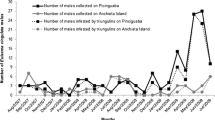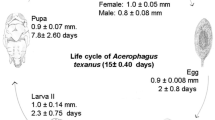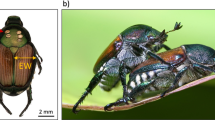Abstract
This study investigated the reproductive biology of the meloid beetle Meloetyphlus fuscatus Waterhouse, a cleptoparasite of Eulaema nigrita nests. New E. nigrita nests had rates of cell parasitism by meloids ranging from 3.7% to 15.8%, while in re-used nests the rate of cell parasitism ranged from 1.4% to 18.7%. The adult parasites were never observed trying to leave the host nests. Both sexes mated more than once. Females had a high fecundity (more than 8,000 eggs), and in most cases, deposited their eggs into the empty, old cells of the host. The triungulins (the first larval instars) hatched from eggs 18–20 days after oviposition and dispersed from the host nest by attaching themselves to males as they emerged. The triungulins most likely transfer to female bees during mating and are transported to the nests of their hosts. Within an attacked cell, the triungulin consumes the bee egg and completes its development by consuming the larval food stored in the cell.





Similar content being viewed by others
References
Ackerman, J.D., Montalvo, A.M. (1985) Longevity of euglossine bees. Biotropica 17, 79–81
Adams, T.S. (2000) Effect of diet and mating on oviposition in the twospotted stink bug Perillus bioculatus (F.) (Heteroptera: Pentatomidae). Ann. Entomol. Soc. Am. 93, 1288–1293
Adams, C.L., Selander, R.B. (1979)The biology of the blister beetles of the vittata group of the genus Epicauta (Coleoptera, Meloidae). B. Am. Mus. Nat. Hist. 162, 137–266
Augusto, S.C., Garófalo, C.A. (2004) Nesting biology and social structure of Euglossa (Euglossa) townsendi Cockerell (Hymenoptera, Apidae, Euglossini). Insectes Soc. 51, 400–409
Bennett, F.D. (1965) Notes on a nest of Eulaema terminata Smith (Hymenoptera, Apoidea) with a suggestion of the occurrence of a primitive social system. Insectes Soc. 12, 81–92
Bennett, F.D. (1972) Observations on Exaerete spp. and their hosts Eulaema terminata and Euplusia surinamensis (Hymen., Apidae, Euglossinae) in Trinidad. J.N.Y. Entomol. Soc. 80, 118–124
Bologna, M.A. (1991) Fauna d’Italia: coleoptera meloidae. Bologna, Edizioni Calderini
Borgmeier, T. (1937) Uma nova especie de Meloetyphlus Waterhouse (1872), e a hypothese da myrmecophilia deste genero (Col. Meloidae). Rev. Entomol. 7, 247–255
Brothers, D.J. (1989) Alternative life-history styles of mutillid wasps (Insecta, Hymenoptera). In: Bruton, M.N. (ed.) Alternative life-history styles of animals, perspectives in vertebral science, vol. 6, pp. 279–291. Kluwer Academic Publishers, Boston
Cameron, S.A., Ramírez, S. (2001) Nest architecture and nesting ecology of the orchid bee Eulaema meriana (Hymenoptera: Apinae: Euglossini). J. Kansas Entomol. Soc. 74, 142–165
De Vieira Jesus, B.M. (1995) Comportamento de nidificação e abundância sazonal de Centris (Heterocentris) analis (Fabricius, 1804)(Hymenoptera, Anthophoridae), MSc. thesis. FFCLRP-USP, Ribeirão Preto
Dodson, C.H. (1966) Ethology of some bees of the tribe Euglossini (Hymenoptera: Apidae). J. Kansas Entomol. Soc. 39, 607–629
Dodson, C.H., Frymire, G.P. (1961) Natural pollination of orchids. Mo. Bot. Gard. bull. 49, 133–152
Ducke, A. (1903) Biologische Notizen uber einige sudamerikanische Hymenoptera. Zs. Allgem. Zs. Ent. 8, 368–372
Erickson, E.H., Enns, W.R., Werner, F.G. (1976) Bionomics of the bee-associated meloidae (Coleoptera); bee and plant hosts of some neartic meloid beetles – synopsis. Ann. Entomol. Soc. Am. 69, 959–970
Garófalo, C.A. (1987) Aspectos bionômicos e sociológicos de Euglossa cordata (Hymenoptera: Apidae: Euglossini), Tese de Livre-Docência, FFCLRP– USP. Ribeirão Preto, Brazil
Garófalo, C.A., Rozen Jr., J.G. (2001) Parasitic behavior of Exaerete smaragdina with descriptions of its mature oocyte and larval instars (Hymenoptera: Apidae: Euglossini). Am. Mus. Novit. 3349, 1–26
Gazola, A.L., Garófalo, C.A. (2003) Parasitic behavior of Leucospis cayennensis Westwood (Hymenoptera: Leucospidae) and rates of parasitism in populations of Centris (Heterocentris) analis (Fabricius) (Hymenoptera: Apidae: Centridini). J. Kansas Entomol. Soc. 76, 131–142
Gerling, D., Hermann, H. (1976) The oviposition and life cycle of Anthrax tigrinus (Diptera: Bombyliidae) a parasite of carpenter bees (Hymenoptera: Xylocopidae). Entomophaga. 21, 227–233
Grissell, E.E., Cameron, S.A. (2002) A new Leucospis (Hymenoptera: Leucospidae), the first known gregarious species. J. Hymenopt. Res. 11, 271–278
Hafernik, J., Saul-Gershenz, L. (2000) Beetle larvae cooperate to mimic bees. Nature 405, 35–36
Horn, W. (1928) (Notes on Meloetyphlus fuscatus), Entomol. Blätter. 24, 88
Kamke, R., Zillikens, A., Heinle, S., Steiner, J. (2008) Natural enemies and life cycle of the orchid bee Eufriesea smaragdina (Hymenoptera: Apidae) reared from trap nests. J. Kansas Entomol. Soc. 81, 101–109
Kimsey, L.S. (1987) Generic relationships within the Euglossini (Hymenoptera: Apidae). Syst. Entomol. 12, 63–72
Lückmann, J. (2005) The courtship behavior of Meloe decorus Brandt and Erichson and Sitaris muralis Foerster (Coleoptera: Meloidae). Coleopt. Bull. 59, 55–61
Lückmann, J., Assmann, T. (2005) Reproductive biology and strategies of nine meloid beetles from Central Europe (Coleoptera: Meloidae). J. Nat. Hist. 39, 4101–4125
Moure, J.S. (1946) Notas sobre as mamangabas. Bol. Agric. Curitiba. 4, 21–50
Moure, J.S. (1964) A key to the parasitic euglossine bees and a new species of Exaerete from Mexico (Hymenoptera, Apoidea). Rev. Biol. Trop. 12, 15–18
Moure, J.S. (1967) A check-list of the know euglossine bees (Hymenoptera, Apidae). Atas Simpos. Biota Amazôn. 5, 395–415
Myers, J.G. (1935) Ethological observations on the citrus bee, Trigona silvestriana, and other neotropical bees. Trans. Roy. Ent. Soc. London. 83, 131–142
Nates-Parra, G. (2005) Abejas corbiculadas de Colombia. Hymenoptera: Apidae. Universidad Nacional de Colombia, Bogota D.C
Nates-Parra, G., González, V.H. (2000) Notas sobre el nido de Eulaema polychroma (Hymenoptera: Apidae: Euglossini). Actual. Biol. 22, 83–90
Pereira-Martins, S.R. (1991) Biologia de Eulaema nigrita. 2. Atividades nidais. Pap. Avuls. Zool. 37, 227–235
Pereira-Martins, S.R., Kerr, W.E. (1991) Biologia de Eulaema nigrita. 1. Construção de células, oviposição e desenvolvimento. Pap. Avuls. Zool. 37, 227–235
Pinto, J.D., Bouseman, J., Bologna, M.A. (1996) First-instar larvae, courtship and oviposition in Electica: amending the definition of the Meloidae (Coleoptera: Tenebrionoidea). Syst. Entomol. 21, 63–74
Ramaswamy, S.B., Shu, S., Park, Y.I., Zeng, F. (1997) Dynamics of juvenile hormone-mediated gonadotropism in the Lepidoptera. Arch. Insect. Biochem. 35, 539–558
Roubik, D.W. (1990) A mixed colony of Eulaema (Hymenoptera: Apidae), natural enemies, and limits to sociality. J. Kansas Entomol. Soc. 63, 150–157
Santos, M.L., Garófalo, C.A. (1994) Nesting biology and nest re-use of Eulaema nigrita (Hymenoptera: Apidae: Euglossini). Insectes Soc. 41, 99–110
Saul-Gershenz, L.S., Millar, J.G. (2006) Phoretic nest parasites use sexual deception to obtain transport to their host’s nest. PNAS 103, 14039–14044
Selander, R.B. (1964) Sexual behavior in blister beetles (Coleoptera: Meloidae). I. The genus Pyrota. Can. Entomol. 96, 1037–1082
Selander, R.B. (1965) The systematic position of Meloetyphlus, a genus of blind blister beetles (Coleoptera: Meloidae). J. Kansas Entomol. Soc. 38, 45–55
Selander, R.B. (1985) A new genus of blister beetles linking Meloetyphlus with Tetraonyx (Coleoptera: Meloidae). J. Kansas Entomol. Soc. 58, 611–619
Torchio, P.F., Bosch, J. (1992) Biology of Tricrania stansburyi, a meloid beetle cleptoparasite of the bee Osmia lignaria propinqua (Hymenoptera: Megachilidae). Ann. Entomol. Soc. Am. 85, 713–721
Waterhouse, C.O. (1872) A new genus and species of Coleoptera allied to Meloe. Entomol. Mon. Mag. 9, 31–32
Zucchi, R., Sakagami, S.F., Camargo, J.M.F. (1969) Biological observations on a tropical parasocial bee, Eulaema nigrita, with a review on the biology of Euglossinae (Hymenoptera, Apidae). A comparative study, J. Fac. Sci. Hokkaido Univ., Series IV. Zool. 17, 271–380
Acknowledgments
This research was supported by Conselho Nacional de Desenvolvimento Científico e Tecnológico (CNPq). We are grateful to C. Costa for identifying the beetle and an anonymous referee for useful comments on the manuscript.
Aspects de la reproduction de Meloetyphlus fuscatus , un coléoptère méloïdé cleptoparasite de l’abeille Eulaema nigrita (Hymenoptera, Apidae, Euglossini)
Cleptoparasitisme / Amérique du Sud / Euglossini / Eulaema / Meloidae / reproduction / développement
Zusammenfassung – Aspekte der Reproduktion von Meloetyphlus fuscatus ein kleptoparasitischer Meloid-Käfer der Biene Eulaema nigrita (Hymenoptera, Apidae, Euglossini) In dieser Studie untersuchten wir die Fortpflanzungsbiologie von Meloetyphlus fuscatus Waterhouse, der einzige bisher identifizierte Meloid-Käfer, der Eulaema-Nester parasitiert. Die Untersuchung wurde zwischen Januar 1983 und März 2003 auf dem Campus der Universität São Paulo in Ribeirão Preto durchgeführt. Alle auf dem Campus vorkommenden Eulaema-Nester wurden registriert, ins Labor gebracht und dort in Beobachtungskästen mit Glasabdeckung gehalten, nachdem die Weibchen ihre Sammelaktivitäten beendet hatten. Nach dem Schlüpfen konnten die Weibchen über Bohrungen in der Laborwand ausfliegen und die Aktivitäten der Bienen und des Parasiten konnten durch die Glasabdeckung beobachtet werden. Insbesondere registrierten wir die Rate der Brutzellparasitierungen in jedem Wirtnest, die Paarungen der Käfer, die Zahl der pro Weibchen produzierten Eier, die Entwicklungszeit der Larven (Triungilinen) bis zum Schlüpfen, sowie das Verhalten und die Verbreitung der Larven aus dem Wirtsnest.
In der Untersuchungszeit wurden insgesamt 23 Nester beobachtet, mit der höchsten Nestzahl in 1996. Ausser diesen Beobachtungen konten wir von 1983 bis 1986, sowie 1990, 1995, 1998, 1999 und 2003 bei 11 Nestern insgesamt 17 Wiedernutzungsereignisse der Nester registrieren (Abb. 1). Alle neuen Nester wurden während der feuchtwarmen Monate (September bis April) angelegt, während die Wiedernutzung von Nestern in allen Monaten, ausser Juni und August erfolgte (Abb. 2). In 12 der 29 neuen Nester fanden wir von Meloiden parasitierte Brutzellen, mit Parasitierungsraten von 3,7 bis 15,8%, wobei die höchsten Parasitierungsraten in 1996 beobachtet wurden (Abb. 3). Parasiten wurden auch in Zellen gefunden, die in neun Wiedernnutzungsereignissen von sechs Nestern verproviantiert worden waren (Abb. 3), und in diesen Fällen lagen die Parasitierungsraten zwischen 1,4 und 18,7%. Die Parasiten schlüpften immer als erste (Abb. 4A). Sie verliessen nie das Wirtsnest und nahmen auch während der ganzen Zeit keine Nahrung zu sich. Paarungen der Meloiden erfolgten im Brutnest von Eulaema und beide Geschlechter paarten sich mehr als einmal. Die Weibchen hatten eine hohe Fekundität und produzierten mehr als 8.000 Eier. Diese wurden in leere alte Brutzellen abgelegt (Abb. 4C) mit Ausnahme eines Falles, bei dem das Weibchen die Eier unter einem kleinem Stein im Beobachtungskasten ablegte (Abb. 4B). Wenn ein Männchen bei der Eiablage zugegen war, blieben diese auf der Zelle mit dem Weibchen sitzen (Abb. 4D). Die braunen Triungulinen-Larven schlüpften nach 18–20 Tagen und ihre Verbreitung erfolgte, indem sie sich an geschlüpfte Bienenmännchen anhefteten (Abb. 5). Diese Triungulinen müssen während der Paarung auf Bienenweibchen übertragen werden und so Zugang zu neu angelegten und verproviantierten Brutzellen bekommen. Nachdem die Zellen verschlossen sind, fressen die Triungulinen die Bieneneier und ernähren sich bis zum Ende ihrer Entwicklung vom Larvenfutter in der Brutzelle. In Wirtsnestern, in denen sich Meloiden beiderlei Geschlechts entwickeln, kommt es zur Verpaarung und zum Beginn eines neuen Zyklus
Euglossini / Eulaema / Meloidae / Meloetyphlus / Kleptoparasitismus
Author information
Authors and Affiliations
Corresponding author
Additional information
Manuscript editor: David Tarpy
Rights and permissions
About this article
Cite this article
Garófalo, C.A., Camillo, E. & Serrano, J.C. Reproductive aspects of Meloetyphlus fuscatus a meloid beetle cleptoparasite of the bee Eulaema nigrita (Hymenoptera, Apidae, Euglossini). Apidologie 42, 337–348 (2011). https://doi.org/10.1007/s13592-011-0023-y
Received:
Revised:
Accepted:
Published:
Issue Date:
DOI: https://doi.org/10.1007/s13592-011-0023-y




